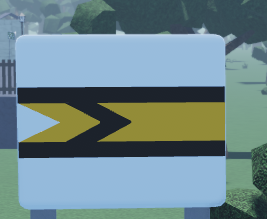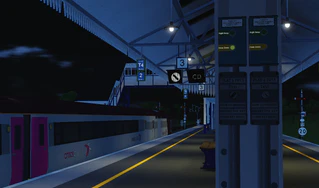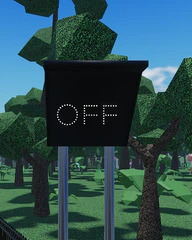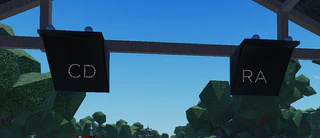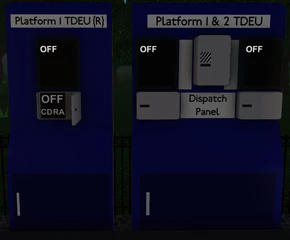More actions
m add navplate |
Bloxbear89 (talk | contribs) Updated information to be current |
||
| Line 3: | Line 3: | ||
==Semaphore Stop Signal== | ==Semaphore Stop Signal== | ||
<!-- [[File:Signal Home Semaphore R & G.svg|right|120px]] !--> | <!-- [[File:Signal Home Semaphore R & G.svg|right|120px]] !--> | ||
Stop signals are the simplest type of signal, informing a driver if they have authority to proceed past the signal. The clearance of a stop signal proves to a driver that the route ahead is clear of an obstruction. | |||
[[File:Semaphore Signal Clear.webp|right|100px]] | [[File:Semaphore Signal Clear.webp|right|100px]] | ||
When cleared, | When cleared, stop signals: | ||
* | * Allow the driver to proceed past the signal until the next stop signal reached. | ||
* Are raised or lowered at a 45 degree angle. | * Are raised or lowered at a 45 degree angle, or 90 degrees vertically in some cases. | ||
* Display a green light. | * Display a green light. | ||
[[File:Semaphore Signal Danger.webp|right|100px]] | [[File:Semaphore Signal Danger.webp|right|100px]] | ||
When at danger, | When at danger, stop signals: | ||
* Do not allow the driver to pass the signal. | * Do not allow the driver to pass the signal. | ||
| Line 19: | Line 19: | ||
* Display a red light. | * Display a red light. | ||
Most stop signals are provided with a white diamond sign on the post. These indicate that the presence of a train is repeated in the signal box, and drivers do not need to notify the signaller if they are waiting at it. | |||
==Semaphore Distant Signal== | ==Semaphore Distant Signal== | ||
<!-- [[File:Signal Distant Semaphore Y & G.svg|right|120px]] !--> | <!-- [[File:Signal Distant Semaphore Y & G.svg|right|120px]] !--> | ||
Distant signals provide advanced warnings as to whether the next stop signals will be at danger or not. This is necessary due to the long | Distant signals provide advanced warnings as to whether the next stop signals will be at danger or not. This is necessary due to the long braking distance of trains. | ||
If the signal is at caution, you must slow down, expecting the next stop signal to be at danger. | If the signal is at caution, you must slow down, expecting the next stop signal to be at danger. The indication of a distant signal applies to all signals until the next distant signal or fixed distant board, so you must be prepared to stop at all other stop signals even if the first one is cleared. | ||
[[File:Distant Signal Clear.webp|right|120px]] | [[File:Distant Signal Clear.webp|right|120px]] | ||
When cleared, distant signals: | When cleared, distant signals: | ||
* Inform the driver all associated stop signals are cleared | * Inform the driver all associated stop signals are cleared. | ||
* Are raised or lowered at a 45 degree angle. | * Are raised or lowered at a 45 degree angle. | ||
* Display a green light. | * Display a green light. | ||
| Line 43: | Line 43: | ||
=== Fixed distant boards === | === Fixed distant boards === | ||
[[File:Fixed.png|frameless]] | [[File:Fixed.png|frameless]] | ||
At | |||
At some places where a distant signal would almost never be in the off position or would require a significant slow down on approach, a board displaying a semaphore distant with a fixed caution indication may be found. These boards should be treated as a distant signal displaying caution. | |||
== Semaphore Subsidiary Signal == | == Semaphore Subsidiary Signal == | ||
[[File:FM03 siding singal.png|right|150px]] | [[File:FM03 siding singal.png|right|150px]] | ||
Subsidiary signals can be found alongside | Subsidiary signals can be found alongside stop signals. They allow the driver to proceed under special circumstances which are not normally permitted. they allow drivers to pass the home signal and proceed ''as far as the line is clear, preparing to stop short of an obstruction.'' This means they can be used to signal trains into an occupied area''.'' | ||
When cleared, subsidiary signals: | When cleared, subsidiary signals: | ||
| Line 61: | Line 62: | ||
==Shunt Discs== | ==Shunt Discs== | ||
Shunt discs comprise of a small white disc with a central red band and two lenses. They are generally found at sidings, yards, or routes on the mainline against the normal direction of traffic, and are often mounted on the ground. Unlike a normal stop signal, shunt discs only allow a train to proceed ''as far as the line is clear, preparing to stop short of an obstruction'', so may be used to signal trains into an occupied area. | |||
[[File:Shunt Disc Clear.webp|right|120px]] | [[File:Shunt Disc Clear.webp|right|120px]] | ||
When cleared, shunt discs: | When cleared, shunt discs: | ||
* Allow the driver to proceed at | * Allow the driver to proceed at caution as far as the line is clear. | ||
* Are rotated 45 degrees. | * Are rotated 45 degrees. | ||
* Display a green light. | * Display a green light. | ||
| Line 75: | Line 76: | ||
* Display a red light. | * Display a red light. | ||
A yellow shunt disc can sometimes be found at a head shunt, comprising a yellow band on a white or black painted disc. Despite being yellow, these signals are unrelated to distant signals. | |||
[[File: | |||
[[File:Yellow shunt disc off.png|right|120px]] | |||
When in the off position, yellow shunt discs: | |||
* Allow the driver to proceed at caution as far as the line is clear. | |||
* Are rotated 45 degrees. | |||
* Display a green light. | |||
[[File:Yellow shunt disc.png|right|120px]] | |||
When in the on position, yellow shunt discs: | |||
* Allow the driver to pass the signal towards the shunt neck or siding, but not towards the running line. | |||
* Are horizontal. | |||
* Display a yellow light. | |||
The | The only yellow shunt disc currently in-game is located at [[Mazewood]]. | ||
==Banner Repeater Signals== | ==Banner Repeater Signals== | ||
[[File:repeaters and OFF indicator at MS.png|200px|right|A banner repeater at Masonfield]] | [[File:repeaters and OFF indicator at MS.png|200px|right|A banner repeater at Masonfield]] | ||
[[File:OFF Banner.gif|right|OFF position]][[File:ON banner.gif|right|ON Position]] | [[File:OFF Banner.gif|right|OFF position]][[File:ON banner.gif|right|ON Position]] | ||
Where the sighting of a signal is adversely affected by curvature or an intervening over bridge or station canopy, etc., an extra signal called a Banner Repeater can be installed to give drivers of approaching trains an earlier view of the indication shown. <br>These are similar to semaphore distant signals. When a banner repeater is at its 'on' state, with a horizontal line, it can be passed, but indicates that the | Where the sighting of a signal is adversely affected by curvature or an intervening over bridge or station canopy, etc., an extra signal called a Banner Repeater can be installed to give drivers of approaching trains an earlier view of the indication shown. <br>These are similar to semaphore distant signals. When a banner repeater is at its 'on' state, with a horizontal line, it can be passed, but indicates that the stop signal ahead is at danger. When a banner repeater is at its 'off' state, with a diagonal line, it can be passed, and indicates that the stop signal ahead is cleared and can be passed safely. Unlike a distant signal however, the indication only repeats the first signal ahead of the banner repeater. | ||
There are two types of Banner Repeater Signals in the game, one being digital, commonly found at stations and lit up on a dot matrix format, and the other being standard banner repeaters found on the line. | |||
Banner repeaters can be found in places like [[Masonfield]] and on approach to [[Dovedale Central]] Station. | |||
== OFF/CD/RA Indicators == | == OFF/CD/RA Indicators == | ||
''Main page: [[Off Indicator]] '' | ''Main page: [[Off Indicator]] '' | ||
| Line 96: | Line 107: | ||
File:OFF Sign.png|An OFF indicator showing OFF. | File:OFF Sign.png|An OFF indicator showing OFF. | ||
File:CD RA Sign.png|OFF indicators showing CD and RA respectively. | File:CD RA Sign.png|OFF indicators showing CD and RA respectively. | ||
File:SatusTDEUs.png| | File:SatusTDEUs.png|An old TDEU once located at [[Satus Services]]. | ||
</gallery> | </gallery> | ||
| Line 112: | Line 123: | ||
== SPAD Indicator == | == SPAD Indicator == | ||
A SPAD indicator | A SPAD indicator may be positioned after a stop signal where there is a high likelihood of a serious collision should a SPAD (Signal Passed at Danger) occur at the signal. <ref> https://www.rssb.co.uk/standards-catalogue/CatalogueItem/RS521-Iss-6 </ref> They are normally unlit, but following a SPAD they display a steady red light between two flashing red lights arranged vertically. | ||
Any driver who sees a SPAD indicator illuminated must stop their train immediately and subsequently contact the signaller for further instructions, even if they can see that the signal pertaining to their line is showing a proceed aspect. SPAD indicators are mounted against a blue backplate and dot matrix lights. | Any driver who sees a SPAD indicator illuminated must stop their train immediately and subsequently contact the signaller for further instructions, even if they can see that the signal pertaining to their line is showing a proceed aspect. SPAD indicators are mounted against a blue backplate and dot matrix lights. | ||
== Semaphore Signals Out of Use (Removed) == | |||
[[File:Crossed out singal.png|right|150px]] | |||
If a semaphore signal is out of use, whether due to failure or not being in operation, they are provided with a cross. Signals that are signed out of use are '''not''' to be obeyed. If they are accompanied by other signals that are in use, they '''must''' be obeyed. Signals in-game do not currently fail, so do not try to put crosses on signals. | |||
The ability to 'cross up' signals was removed in Version 1.2, as signals were reworked to no longer break in earlier versions. | |||
== References == | == References == | ||
Revision as of 11:22, 20 December 2024
A signal is a tool that displays an indication of the track status ahead for drivers. There are several types of signals listed below that can be found in game. All of the signals are controlled by Signal Boxes. Refer to the Signalling Guide to learn how to operate signal boxes.
Semaphore Stop Signal
Stop signals are the simplest type of signal, informing a driver if they have authority to proceed past the signal. The clearance of a stop signal proves to a driver that the route ahead is clear of an obstruction.
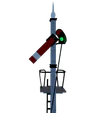
When cleared, stop signals:
- Allow the driver to proceed past the signal until the next stop signal reached.
- Are raised or lowered at a 45 degree angle, or 90 degrees vertically in some cases.
- Display a green light.
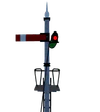
When at danger, stop signals:
- Do not allow the driver to pass the signal.
- Are horizontal; at a 90 degree angle.
- Display a red light.
Most stop signals are provided with a white diamond sign on the post. These indicate that the presence of a train is repeated in the signal box, and drivers do not need to notify the signaller if they are waiting at it.
Semaphore Distant Signal
Distant signals provide advanced warnings as to whether the next stop signals will be at danger or not. This is necessary due to the long braking distance of trains.
If the signal is at caution, you must slow down, expecting the next stop signal to be at danger. The indication of a distant signal applies to all signals until the next distant signal or fixed distant board, so you must be prepared to stop at all other stop signals even if the first one is cleared.
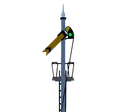
When cleared, distant signals:
- Inform the driver all associated stop signals are cleared.
- Are raised or lowered at a 45 degree angle.
- Display a green light.

When at caution, distant signals:
- Inform the driver that they should expect one of the following stop signals to be at danger and must slow down.
- Are horizontal; at a 90 degree angle.
- Display a yellow light.
Fixed distant boards
At some places where a distant signal would almost never be in the off position or would require a significant slow down on approach, a board displaying a semaphore distant with a fixed caution indication may be found. These boards should be treated as a distant signal displaying caution.
Semaphore Subsidiary Signal
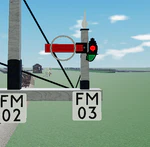
Subsidiary signals can be found alongside stop signals. They allow the driver to proceed under special circumstances which are not normally permitted. they allow drivers to pass the home signal and proceed as far as the line is clear, preparing to stop short of an obstruction. This means they can be used to signal trains into an occupied area.
When cleared, subsidiary signals:
- Allow the driver to pass the main signal cautiously.
- Are raised or lowered at a 45 degree angle.
- Display a green light.
When at danger the driver must obey the main home signal. Subsidiary signals:
- Are horizontal; at a 90 degree angle.
- Display a red light.
Shunt Discs
Shunt discs comprise of a small white disc with a central red band and two lenses. They are generally found at sidings, yards, or routes on the mainline against the normal direction of traffic, and are often mounted on the ground. Unlike a normal stop signal, shunt discs only allow a train to proceed as far as the line is clear, preparing to stop short of an obstruction, so may be used to signal trains into an occupied area.

When cleared, shunt discs:
- Allow the driver to proceed at caution as far as the line is clear.
- Are rotated 45 degrees.
- Display a green light.

When at danger, shunt discs:
- Do not allow the driver to pass the signal.
- Are horizontal.
- Display a red light.
A yellow shunt disc can sometimes be found at a head shunt, comprising a yellow band on a white or black painted disc. Despite being yellow, these signals are unrelated to distant signals.

When in the off position, yellow shunt discs:
- Allow the driver to proceed at caution as far as the line is clear.
- Are rotated 45 degrees.
- Display a green light.
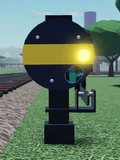
When in the on position, yellow shunt discs:
- Allow the driver to pass the signal towards the shunt neck or siding, but not towards the running line.
- Are horizontal.
- Display a yellow light.
The only yellow shunt disc currently in-game is located at Mazewood.
Banner Repeater Signals



Where the sighting of a signal is adversely affected by curvature or an intervening over bridge or station canopy, etc., an extra signal called a Banner Repeater can be installed to give drivers of approaching trains an earlier view of the indication shown.
These are similar to semaphore distant signals. When a banner repeater is at its 'on' state, with a horizontal line, it can be passed, but indicates that the stop signal ahead is at danger. When a banner repeater is at its 'off' state, with a diagonal line, it can be passed, and indicates that the stop signal ahead is cleared and can be passed safely. Unlike a distant signal however, the indication only repeats the first signal ahead of the banner repeater.
There are two types of Banner Repeater Signals in the game, one being digital, commonly found at stations and lit up on a dot matrix format, and the other being standard banner repeaters found on the line.
Banner repeaters can be found in places like Masonfield and on approach to Dovedale Central Station.
OFF/CD/RA Indicators
Main page: Off Indicator
-
An OFF indicator at Masonfield.
-
An OFF indicator showing OFF.
-
OFF indicators showing CD and RA respectively.
-
An old TDEU once located at Satus Services.
OFF Indicators are found at stations with dispatching capabilities, and used to inform the driver if they can move on from the station, and what to do. They are controlled by Train Dispatch Equipment Units (TDEU), which are usually at the side of the platform in blue. These are currently present at Masonfield, Dovedale Central and Fanory Mill, and could previously be found at Satus Services and Glassbury Junction.
- An illuminated OFF indication means the associated signal is showing a proceed aspect, and they can proceed on.
- An illuminated indication CD (close doors) is an instruction to close the train's power-operated doors.
- An illuminated indication RA or R (right away) means that station duties are complete and the train may depart.
OFF - Signal ahead is clear
CD - Close Doors
RA - Right Away
SPAD Indicator
A SPAD indicator may be positioned after a stop signal where there is a high likelihood of a serious collision should a SPAD (Signal Passed at Danger) occur at the signal. [1] They are normally unlit, but following a SPAD they display a steady red light between two flashing red lights arranged vertically. Any driver who sees a SPAD indicator illuminated must stop their train immediately and subsequently contact the signaller for further instructions, even if they can see that the signal pertaining to their line is showing a proceed aspect. SPAD indicators are mounted against a blue backplate and dot matrix lights.
Semaphore Signals Out of Use (Removed)

If a semaphore signal is out of use, whether due to failure or not being in operation, they are provided with a cross. Signals that are signed out of use are not to be obeyed. If they are accompanied by other signals that are in use, they must be obeyed. Signals in-game do not currently fail, so do not try to put crosses on signals.
The ability to 'cross up' signals was removed in Version 1.2, as signals were reworked to no longer break in earlier versions.
